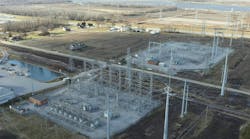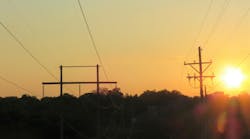The Static Var Compensator (SVC) built by Siemens Power Transmission and Distribution (PTD) in Radsted on the island of Lolland on behalf of the largest Danish consumer owned power company, SEAS-NVE, went into operation in summer 2007. The main reason to integrate the compensator in the network was voltage fluctuations caused by the 165.5 MW Nysted offshore wind park connected to the offshore platform, also operated by SEAS-NVE, which affected the voltage quality in the 132-kV transmission network. The Siemens system provides the reactive power needed for this, improves the voltage quality and increases the system stability of the weak transmission grid in the south of Denmark. It will also help minimizing any impact on the transmission system in the future that results from further wind farms planned in this region.
The main element of the Danish turnkey project is the Static Var Compensator for the 132-kV transmission system in the Radsted high-voltage switchgear station on the island of Lolland. This also includes the expansion of the existing 132-kV outdoor switchgear station for linking the SVC to the power grid. Siemens developed an advanced, innovative solution for Radsted that met the requirements of the power company while also complying with the extremely high standards for noise abatement. The SVC system operates in a twelve-pulse configuration consisting of a thyristor-controlled reactor (TCR) and one filter in each of the two secondary circuits of the high-voltage transformer. The twelve-pulse configuration has the advantage that the odd-order harmonics which are generated by each of the TCR branches mutually compensate each other. This configuration thus helps the system fulfill the strict requirements in terms of maximum occurrence of undesired harmonics at the system connection point.
In order to meet the rigid audible noise requirements that apply in the vicinity of the system, the SVC has been enclosed completely inside a building for the first time and has been equipped with special noise deadening materials and components. Since the height of the building must not exceed six meters, Siemens optimized the equipment configuration of the SVC accordingly.
Static Var Compensation is a part of the FACTS technology (Flexible Alternating Current Transmission Systems). FACTS can control the parameters that determine the operation of the power grid and define for the quality of transmission. These parameters include transmission impedances, currents, voltages and phase angles between the different network nodes. A distinction is made in reactive power compensation between parallel and series compensation. Series compensators connect capacitors – if necessary in combination with controllable reactors (TCR) – into the high-voltage transmission line. This fixed or variable reactive impedance reduces the transmission angle so that greater active power can be transmitted without jeopardizing the stability of the system.
In the case of parallel compensation, a variable reactive power source feeds into a selected network point via a transformer. The reactive power needed in each case is generated there in order to keep the voltage at a constant level. The system voltage can be exposed to undesired fluctuations due to load shut off or power system faults, such as short-circuits, which need to be controlled quickly. As in the Radsted substation, this function is performed by a Static Var Compensator within its power range, which is designed to match the particular network.



